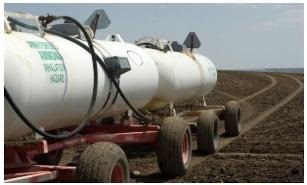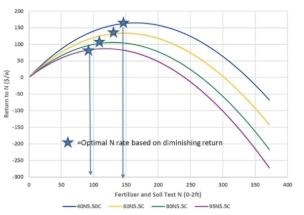By Anthony Bly
Most everyone has realized that fertilizer prices have drastically increased since last summer. There are many contributing factors for this increase, which aren’t relevant in front of the difficult decisions necessary for profitable crop production in 2022. In order to effectively select a profitable Nitrogen (N) rate for corn, it is very important to have an understanding of what leftover (residual) soil nitrate is in the soil, calculate an accurate yield goal and understand how the price of N and corn affect the economically optimal N rate.

South Dakota is on the western edge of the Corn Belt. Our state receives much less precipitation on average than areas to our east. Since we are drier, soil fertility researchers in the Great Plains and South Dakota have found that taking credit for “residual” N is a good practice when determining a fertilizer N rate for corn. The chances of losing the nitrate in the soil are very low, since most of our soils can hold significant amounts of water. Of course, sampling for nitrate-N in the soil as close to corn growth and uptake would be the best management practice; however, any sample from fall or spring is better than no samples at all.

Figure 1. The influence of the prices of corn and fertilizer Nitrogen (N) on the economically optimal N rate for corn in South Dakota.
Determining an accurate yield goal is crucial for determining an accurate N rate. Yield goal, “is not the yield you want, but it is the yield you can get!” Using the Olympic yield average is the best way to determining a yield goal. One should take that last five to 10 years of yield data. Remove the obvious low or high yields and determine the average of the remaining yields. A yield trend adjustment should also be applied to the average to compensate for improved hybrids and corn management. Usually 5% is a good value to increase the average yield. The yield trend adjustment is flexible and should be determined according to local experience with yield successes or struggles.
Corn response to applied N is not even across the applied N rates. For example, at lower application rates, more bushels of corn are produced compared to higher application rates, where the incremental yield increase is diminished to a point of no further yield improvement. The price of corn and nitrogen can greatly influence the point of diminishing returns on the corn response curve for nitrogen. When corn and fertilizer N are relatively low, the effect of price is minimized. However, during a year when prices are high, the effect is much greater and is noticeable. Look how the price of N can influence the economically optimal N rate when the price of corn is held constant (Figure 1). As the price of N increases, the economically optimal N rate decreases. While we cannot know what the price of N will be next year, it is very important to understand how the level of both prices will influence corn profitability for 2022.
Source : sdstate.edu